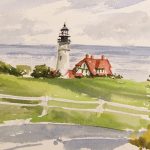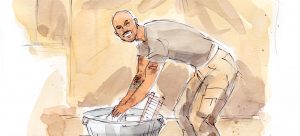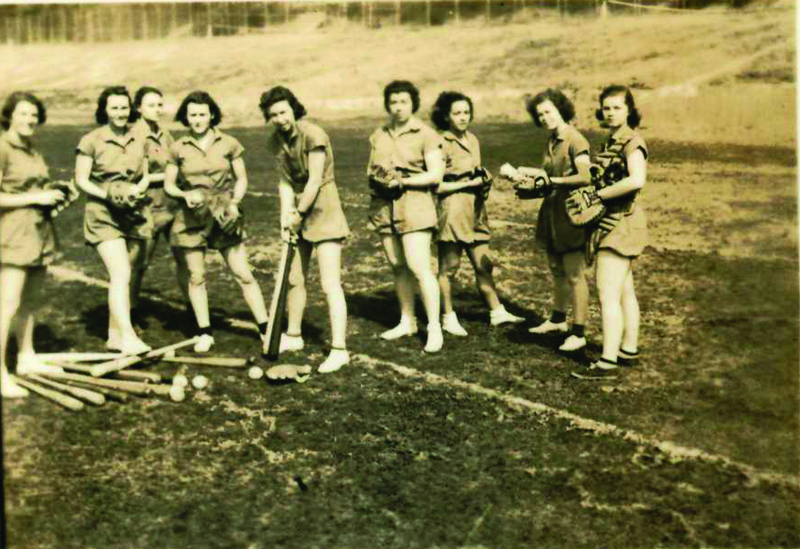
How an unheralded pioneer of women’s golf created a life of meaning and joy
By Jim Moriarty
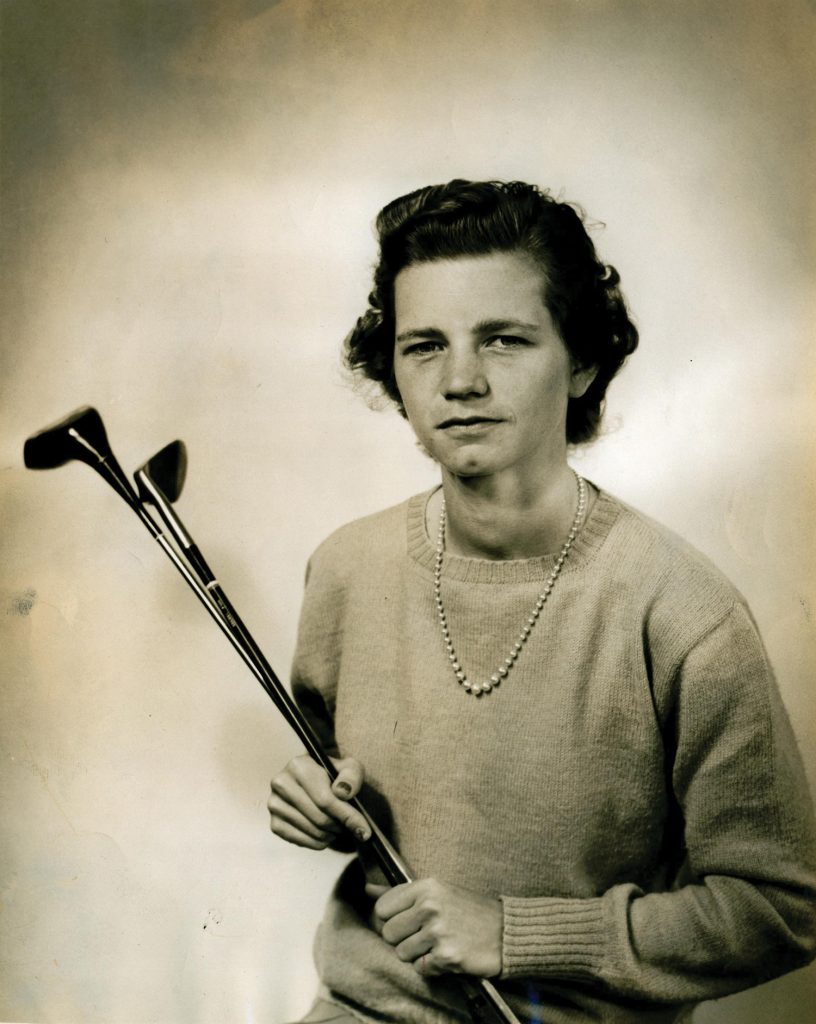
Charlie Griffin hadn’t given up golf, exactly; he’d just taken a 30-year sabbatical. Senior advisers at the World Bank — his last position was as the director for Human Development in Eastern Europe and Central Asia — don’t generally travel with yardage books in their back pockets. In an effort to reboot his game in retirement, Griffin booked a lesson with Joy Bonhurst at Clubgolf Performance in the Maryland suburbs of Washington, D.C. In their get-to-know-you conversation, Bonhurst asked Griffin where he learned to play. Griffin explained that his aunt taught him the game when he was very young.
“Griffin,” thought Bonhurst. “Aunt” thought Bonhurst. “You must be Ellen Griffin’s nephew.” Guilty as charged. When Griffin stopped at the desk to pay for his lesson, Bonhurst spoke up. “Be respectful of this guy,” she said to the man at the cash register. “He’s from golf royalty.”
Ellen Griffin passed away over three decades ago at the age of 67 following a years-long series of surgeries, 16 in all, the first few for cancer, the rest to treat chronic Crohn’s disease. She tossed in a pair of strokes along the way. After the first one she gave up smoking her Raleigh cigarettes. After the second one she taught herself Spanish. “I don’t believe I’m going to be blotted out when I die,” she once told author Liz Kahn. “But it’s a new experience, and no one knows about it, so why worry?” She died in October of 1986 with the Major League Baseball championship series on the TV in her room at Moses Cone Hospital. Blotted out? As John Wayne said in Big Jake, “Not hardly.”
Blowing the dust off the accolades and achievements is a futile exercise in understatement, even if it were possible to touch all the bases. The Ladies Professional Golf Association’s annual teaching award is named the Ellen Griffin Rolex Award. The first-ever recipient in 1989 was another member of golf royalty, her close friend Peggy Kirk Bell. Together they brainstormed the Golfari name and concept that became a 60-year plus staple at Pine Needles Lodge and Country Club in Southern Pines. Griffin created the National Golf Foundation’s Educational Services Program and was the LPGA’s Teacher of the Year, both in 1962. Ten years before that she and Betty Hicks, co-authored the Golf Manual for Teachers, an indispensible tool of its time for college golf instructors. And, in 1944, along with Hicks and Hope Seignious, Griffin was one of the founders of the Women’s Professional Golf Association, a precursor to the LPGA.
The WPGA was launched using cotton money supplied by Seignious’ father, but its eyes were bigger than its stomach. It fostered a fledgling winter tour in Florida in ’45 and published a monthly magazine, The Woman Golfer, in ’46 and ’47 with a newsstand price of 25 cents — assuming you could find it on a newsstand — aided by Smith Barrier, a former sports editor at the Greensboro Daily News. And, though the WPGA surely wasn’t the sole motivating factor, the first U.S. Women’s Open was played in Spokane, Washington, in ’46. The time was ripe for something, just not the WPGA. It lacked three things: the uber promoter Fred Corcoran; the uber female athlete Babe Zaharias; and the not-so-uber but nonetheless reliable money of Wilson Sporting Goods, which came hand-in-glove with Nos. 1 and 2. The 13 LPGA founders (14 if you add Peggy Kirk Bell, which the founders always did) coalesced in ’49. That the LPGA had picked up the baton as the WPGA’s well ran dry bothered Griffin not a whit. She’d never intended to be a nomadic playing professional. She was a teacher, pure and simple. And therein lies the magic.
To say that Ellen Griffin was incorrigibly optimistic would be like saying a golf ball was determinedly round. It was simply one of her properties, like the sleight of hand tricks she pulled on kids of all ages. “She was one of those people that just affected your thinking and your feelings about yourself without directly talking about it,” says sports psychologist Dr. Bob Rotella, who met Griffin through another respected woman teaching professional, DeDe Owens. “We brought her to the University of Virginia a couple of times to do clinics and everyone just loved her. She not only loved teaching players, she loved teaching teachers of players. She just had an incredible ability to make the game really simple. She had that knack of making you feel good.”
Her nephew, Charlie, lived with Griffin while he finished high school in Greensboro in the late ’60s, ultimately on the path to degrees at the University of Iowa, UNC-Chapel Hill, Duke and then the World Bank. “She was a free-thinking, inventive, creative saint, and she showered all of that on me for three years,” he says. “It was just infectious. Her method was Socratic. She was always asking questions so she made a real pest of herself. Ellen was like the most annoying saintly person you’d ever want to be around. She never left you alone.”
The oldest of three children, Ellen’s younger brother Charles became a physician in Dyersville, Iowa, and outlived her. A second brother, George, 10 years younger than Charles, was a Korean and Vietnam War veteran with 20 years in the Army and Air Force, combined. He died in 1977 at the age of 46. Her mother, Helen, was a niece of J. Edgar Hoover. Her father, Charles, was from Snow Camp, North Carolina, the seventh child in a family of 17. He retired with the rank of colonel after 39 years in the U.S. Army, was a veteran of both World Wars, suffered shrapnel wounds to his legs, was awarded a Purple Heart, survived a mustard gas attack, carried an embarrassing tattoo on his left arm — a basket of flowers with “Mother” written underneath — was the power-hitting catcher on the 29th Infantry baseball team at Fort Benning, Georgia, an expert rifleman and one of the best golfers at any base where he happened to be assigned. He saw his 7-month-old daughter for the first time when he returned from France at the end of World War I. That daughter found him behind his trailer in Level Cross, North Carolina, where he suffered a heart attack while shooting mistletoe out of a tree and died at the age of 58.
Between the World Wars, when the family was based in Georgia, Ellen’s father took her to a local golf professional, who gave her a cut down 2-iron with a hickory shaft, which she used to great effect on Fort Benning’s parade ground. “I was lucky my father was in the Army because we could open the golf course every Sunday at 6 a.m. He played 18 holes with me, then took me for a chocolate milk, after which I went to church, and Dad played golf with his men friends,” Griffin told Kahn in The LPGA: The Unauthorized Version. Her brother Charles, whom everyone called June, was pressed into service as a caddie. “My dad taught Ellen to play golf when she was 11. He taught me to caddie when I was 9. I was the original double-bagger on Sunday,” he said at Ellen’s 2002 induction into the LPGA’s Teaching and Club Professional Hall of Fame.
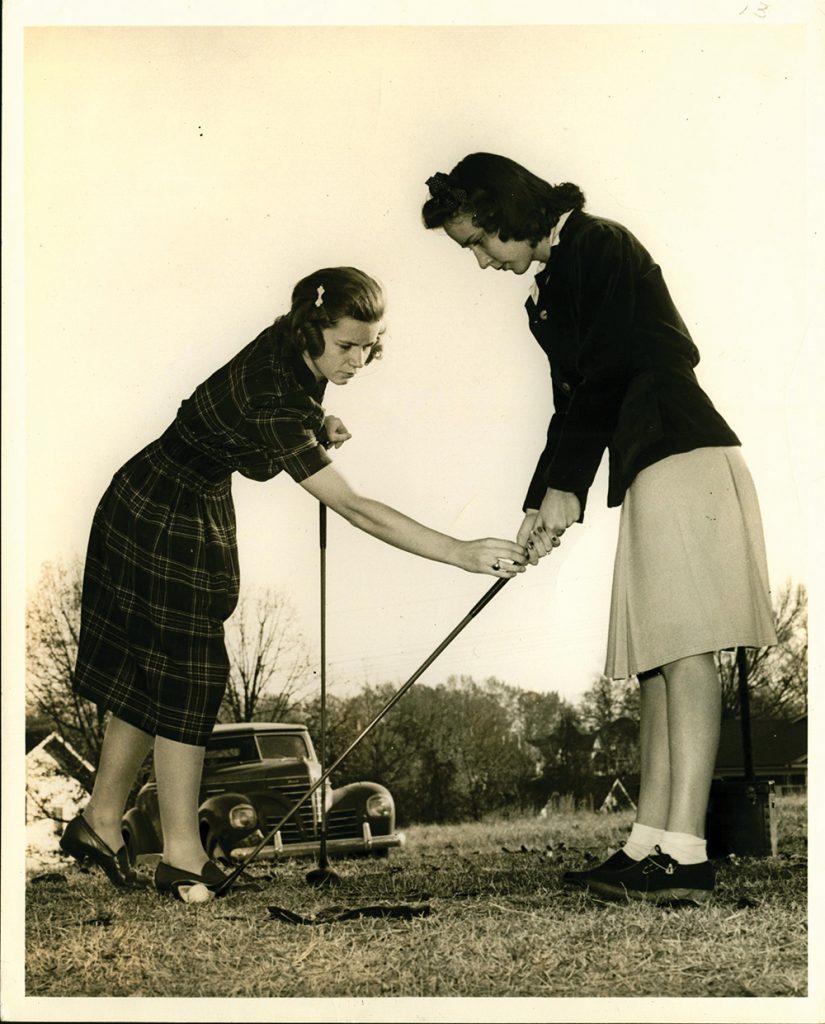
Once Ellen entered Woman’s College of the University of North Carolina, now UNCG, part of her never left it, though she ultimately did. She entered in 1936-37, graduated in 1940 and taught physical education at the university straight through to 1968, with the exception of her brief stint at the National Golf Foundation. One of her students was Annette Thompson, who grew up on a farm in Jackson Springs, was part of a graduating class of 26 at West End High School, and would receive the Ellen Griffin Rolex Award in 2002. “It’s hard to verbalize her influence because it was the person more than anything she said or did,” says Thompson. “She had that nebulous quality that makes somebody really special.” Griffin was the faculty adviser for LPGA Hall of Famer Carol Mann. “I took life lessons from her, not golf lessons,” says Mann. “Ellen Griffin was one of the most authentic people I ever met in my life.”
In addition to Griffin’s notes on how to teach virtually any sport known to man or woman, the archive at UNCG’s Jackson Library has two of her scrapbooks, neither one completely full, compiled during her undergraduate years. The edges of the pages crumble and crack like an Indiana Jones map. Nearly everything, one assumes, was worth saving. Terse, businesslike single sentence notes to attend a meeting in a professor’s office. Telegrams from her mother saying she couldn’t be there on such and such a day. A ticket stub from a Nelson Eddy concert in 1937. A coaster advertising something called Trommer’s Malt Beer. A note informing her she was considered overweight — at 62.4 inches and 126 pounds — and a printed card with suggested remedies: 4. Take a cool or cold bath every day; avoid extremely hot baths, as they are weakening. A limerick. A golf essay. A newspaper clipping saying she’d been elected junior class president. Her first semester freshman grades. The starting lineup of the university’s softball team — she was a catcher like her father and batted cleanup. No one item appears any more important than any other. It’s a collage of someone spellbound by life.
Beginning in ’66 and for the next three years, Ellen’s nephew, Charlie, the fourth of Charles’ 10 children from his first marriage, lived with her and her mother on Logandale Court, near old U.S. 421. Ellen drove him to school every day. They played golf every Sunday. “I would wear a suit with shorts underneath. She would drive me to the Catholic church on Market Street, drop me off and then pick me up and we’d go play at the UNCG golf course. That’s how she taught me how to play,” he says.
There was a lot to learn besides golf. “She had to have the latest technology of everything. She had the first color TV. She had the first Amana Radarange,” says Charlie. “That was very important because it made her breakfast much more efficient. Her system of creativity started at 5 a.m. every day. She’d cook two slices of bacon in the Radarange. She made two poached eggs and coffee. She wasn’t sick then but she had a hospital bed she would raise and lower electrically. She had a tray that would roll across the bed like a desk, and she would eat her breakfast and for those two hours think and write and plan. It was a quiet time when nobody could bother her, and it happened every single day of her life that I knew her.”
In 1968, Griffin walked away from her position as an associate professor at UNCG, eventually creating The Farm, her teaching facility in Randleman, on land owned by her brother, June, who relocated, however briefly, from Iowa to North Carolina. “It wasn’t just a business, it was an experience,” says Mann. Griffin kept her money in an old metal cash box. Written on top was, “The sole purpose of business is to make money but that’s not the soul purpose.”
Off Route 62, the land where Richard Petty once took a golf lesson is now occupied by one of June’s stepdaughters and her husband. The driving range is still mowed. There are flags in faux greens for targets. Some persimmon and apple trees remain. The pine trees that Ellen planted along two sides of the range are large enough now to aspire to being described as towering. Queen Anne’s lace grows in great swaths on the edges. Gone are the peacock, Mann, and the peahen, Carol, that once perched on the railing of the outbuilding Ellen called the Tee House. Instead of being full of student desks occupied with golf pupils from ages 7 to 70, it’s a man cave. The guinea hens and the mockingbird have disappeared. The poodles no longer curl up in the sun. The property next door doesn’t have cows anymore. The cement duck pond is dry. There is no need for anyone to shoo a wandering animal out of the line of fire on the range as Griffin did with the 8-iron she constantly carried or the bucket hat she always wore — both of which went to the grave with her — or the pants with the baggy back pockets that seemed to swallow her balled-up fists as she watched a student and asked questions in that low, husky voice. The visitors now are woodchucks and deer.
Dot Germain, Ellen’s protégé who played the LPGA Tour for 15 years and was the person who turned on the baseball games in Griffin’s final hospital room, owned a house through the woods on one end of the property. “She called herself the world’s greatest putter,” Germain recalls. “We’d have putting contests for millions of dollars.” A product of the imagination, of course, like everything else Griffin did. Debbie Massey, who played the LPGA Tour for 18 years, spent another five with Griffin and Germain in Randleman. “The Farm was really like being surrounded by Ellen’s life,” she says. “It was not just golf. It was science and nature and philosophy, psychology and mathematics that absolutely enveloped her life and golf was part of that.”
Sometimes at the end of a long day, Griffin, Germain and Massey would sneak off to play the nearby nine-hole Green Acres Golf Course. “It was
one of those courses that still had those three-wheel carts. You took your
life in your hands every time you played there. She loved that little golf course,” says Massey.
Ellen would get a package of cheese crackers and a chocolate milk, just like her Georgia days. “Sometimes she had me look at her swing,” says Germain. “I’d think, ‘Oh, yeah, she wants me to observe something. Make a suggestion. No, it was, ‘Look how good I am.’ Well, OK, Ellen.”
Griffin knew who she was. A golf lesson with her didn’t start until she knew who you were. Massey had been a ski instructor. “She used my skiing to help teach me because the footwork is very similar. And she knew that I loved mathematics. For my alignment routine she used angles and lines that I could see in the ground. To this day, I see them,” she says. “She used those specific things, skiing and mathematics, to teach me. For someone else it would be something different.”
In the evening at The Farm, after filling her favorite tall beer glass a time or two, Griffin might be seen dancing in the kitchen. A devotee of the New Orleans second line, Ellen loved the strut. “She was a performer, too. She’d get up and she’d get her hands up in the air and she’d start to strut around and she’d say, ‘This is how you do it,’” says Massey. “She’d have us all up banging with spoons, whatever we could find. And you could see her dancing in her golf swing. She had a beautiful swing, very athletic and a lot of footwork.”
In 1971, when Ellen was transitioning from the university to The Farm, something her nephew identifies as a Griffin family trait (“a long, proud tradition of completely throwing your career out the window and going into the great void,” he says), she indulged her artsy side. One of the ways was publishing the sayings she jotted down in those early morning hours that became A Book of Yours. The dedication is to three people, mentioned only by their initials. No one knows who the initials represent. Ellen never told. Each first edition was numbered, the way an artist numbers prints. Germain’s copy is 204 of 240. No. 1 is unaccounted for.
The book’s observations/poems are printed on rough-cut thick pages that surround pieces of exquisite, delicate Japanese rice paper. The last page reads:
One leaf left —
One last leaf
Defying the winds —
Tonight
It has decided
When the air is calm
And
The ripples are ironed on the lake
It will float softly
To the moss bank
And
Pray.
Some artist’s medium is simply being alive. What a masterpiece it was. OH
Jim Moriarty is the senior editor of O.Henry’s sister publication, PineStraw and can be reached at jjmpinestraw@gmail.com

